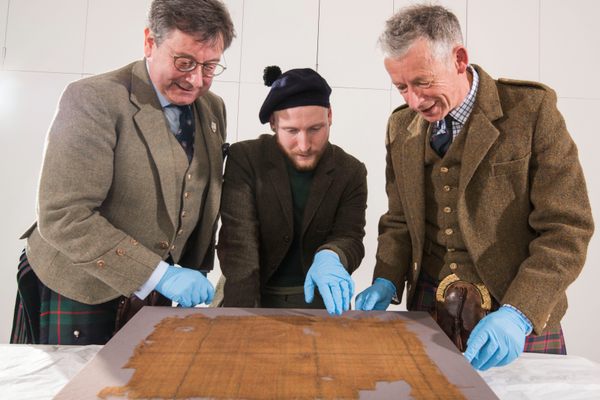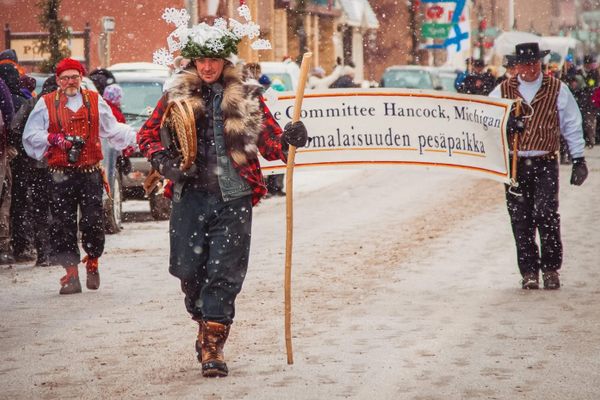Before Harry Potter’s Sorting Hat, There Was the ‘Medieval Space Bonnet’
Legends swirl around the University of Edinburgh’s mysterious graduation bonnet.
On a grey and drizzly afternoon in the University of Edinburgh’s opulent graduation hall, J.K. Rowling waited to receive an honorary degree. But before the degree could be conferred, she had to take part in a long-standing tradition. University Principal Timothy O’Shea merrily explained that she, along with all graduating students, must step forward and be tapped on the head with an object he calls “the medieval space bonnet.”
This curious tradition, which calls to mind Rowling’s own Sorting Hat ceremony in Harry Potter, is steeped in legend. However, restoration work on the so-called space bonnet, more commonly known as the Geneva Bonnet, has brought much of that legend into question.
The University of Edinburgh’s Sorting Hat-style graduation ceremony has been in place for at least 150 years, in which time the bonnet has tapped the heads of over 100,000 graduates. But the round silk and cloth bonnet is rumored to be much older than that. Legend has it that the bonnet was made from a pair of trousers that belonged to 16th-century Scottish Reformation leader John Knox.

Alasdair Raffe, an early modern Scottish historian at the university, says Knox “played an enormous role in shaping Scotland’s history. His charismatic leadership style helped ensure the success of the Reformation.” His efforts changed Scotland’s political and social landscape forever.
Knox died shortly before the University of Edinburgh was founded in 1583, but his legacy and influence played an important role in the university’s early years. Many of the school’s earliest students studied to become Protestant clergy like Knox.
As a nod to Knox’s legacy, the university has a statue of him holding a Bible and wearing a hat—one very similar to the Geneva Bonnet—located outside the School of Divinity. When the university constructed a purpose-built graduation hall in 1897, a depiction of the centuries-old bonnet ceremony was carved in stone above the front door.
However, the age of the “medieval” bonnet was called into question in the early 2000s, when the university arranged to restore the hat. The restoration was sponsored by Ede and Ravenscroft, London’s oldest tailor, who supply graduation gowns to universities across the United Kingdom. During the bonnet’s restoration, a conservator found a note inside the hat’s lining that read: “Henry Banks 22 Duke Street Edinr 31 July 1849.”
The 1851 census confirmed that Banks was a merchant tailor, casting doubt on the true age of the bonnet. According to a statement released by the university, the conservator also estimated that the fabric dates from the mid-19th century, rather than the rumored date nearly 300 years earlier. If the bonnet does date to John Knox, then none of the original material appeared to have survived. Some people, including many at the university, have hoped that this date confirmed a 19th-century restoration, rather than the date of the bonnet’s creation. This includes former Principal of the university, Timothy O’Shea, who says that “repeatedly tapping the heads of thousands of graduates would be bound to wear down the original fabric.”

Beyond its ceremonial duties, the bonnet has also been to space—well, at least a part of it. In 2006, astronaut and Edinburgh alumnus Piers Sellers contacted then-principal Timothy O’Shea and asked for permission to take the Geneva Bonnet with him to the space station. While O’Shea was open to the idea, he says that university officials told him it would be “an act of extraordinary madness to take the sacred bonnet into space!” As a compromise, Sellers took a small patch of velvet embroidered with the university crest with him on his mission. This patch was later sewn into the ceremonial hat, leading to the nickname “the medieval space bonnet.”
The bonnet made another unexpected trip in 2021, this time to Edinburgh Castle. Due to the COVID-19 pandemic, the university’s graduation hall was deemed too small for social distancing, so the graduating class of 2020 and 2021 were invited to a special ceremony in the Great Hall at the castle, complete with the Geneva Bonnet. Erin Pringle, a graduating student at the 2021 ceremony, says, “getting to graduate in the great hall at Edinburgh Castle was a once-in-a-lifetime experience! It felt historic and magical to walk through the castle in your graduation gown and be bopped on the head by John Knox’s bonnet, just like being in the great hall at Hogwarts.”
Although J.K. Rowling has never acknowledged the similarities between this ancient tradition and her famous Sorting Hat, it’s clear that some graduates of the university like to think of this as their very own sorting ceremony.
For most people, whether or not the hat is from the 16th century isn’t important. What’s more important is what the hat symbolizes. Graduations are a rite of passage, and many people only get one chance to dress up in their robes and embrace the pomp and ceremony of the day. Perhaps the strange tale of the Geneva Bonnet offers a small way for graduates to feel the weight of history as they enter a new chapter in their lives.



































Follow us on Twitter to get the latest on the world's hidden wonders.
Like us on Facebook to get the latest on the world's hidden wonders.
Follow us on Twitter Like us on Facebook